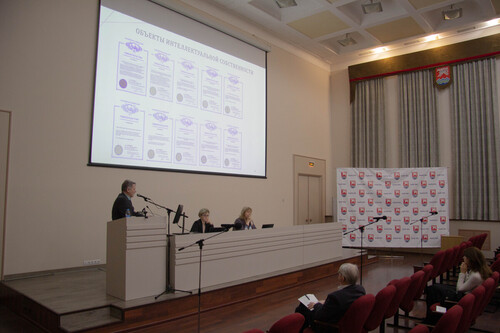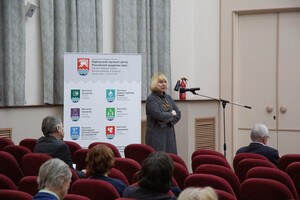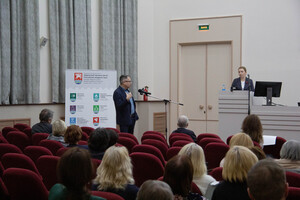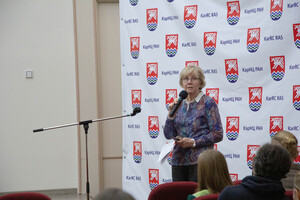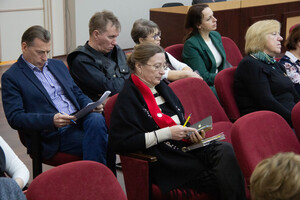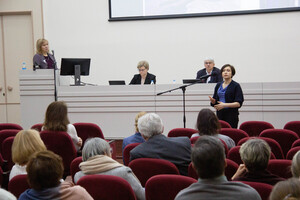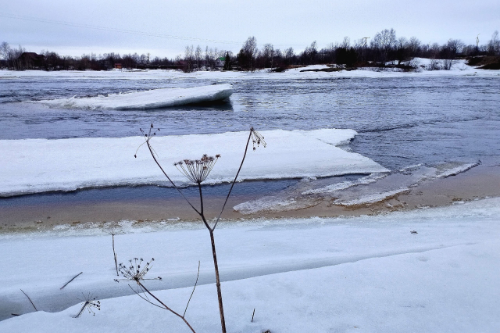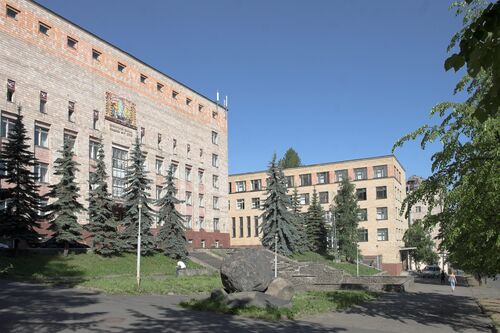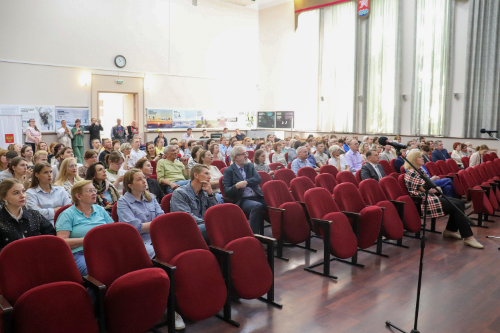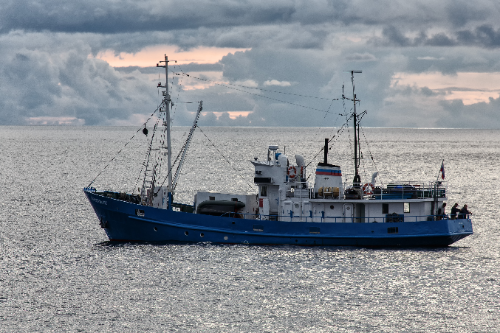The main areas and results of the research were presented by Yuri Zaika, Director of the Institute. In the field of computational materials science (knowledge of how materials behave under extreme conditions), a model of hydrogen thermodesorption from structural materials and hydrogen permeability was presented.
Studies of the random forest method, a classical algorithm in mathematics, were continued. The scientist informed that the aspect studied now in this respect is the problem of giant components. In practice, such knowledge enables monitoring and evaluating fatal Internet traffic overload.
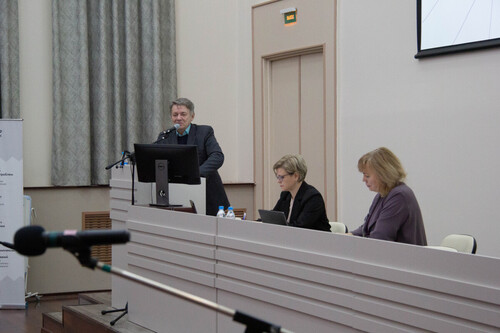
Speaking is Yuri Zaika, IAMR KarRC RAS Director
Karelian mathematicians also worked on the analysis of the dynamics of biological communities.
— Mathematical biology has a long history, but at the present stage it provides opportunities to study more and more characteristics of a biosystem: species interactions, predator migrations and prey dynamics in the absence of a predator, and others. This study was supported by an RSF grant. The results can be used not only in behavioral ecology, but also in the construction of decision-making processes in other fields, — remarked Yuri Zaika.
Other work of researchers in the past year concerned dynamical games, queuing systems analysis, quantum computing, research on science communication systems, and other areas. Modeling of traffic flows in Petrozavodsk using game-theoretic methods was continued.
— We submitted a mathematical substantiation of where and how the situation can be improved by the introduction of new routes in the city to the republic's authorities. RSF funding has ended, but we hope to continue the work, as our specialists have many ideas in this regard, — added Anna Rettieva, Deputy Director for Science3, IAMR KarRC RAS.
Last year, IAMR KarRC RAS staff published a total of 86 papers, including 52 articles in peer-reviewed journals.
Mathematicians work in close collaboration with the Petrozavodsk State University, RAS institutions, universities of China and India. In August, scientists held a SMARTY 2024 International Workshop on stochastic modeling and applied research of technology. The workshop brought together scientists from different countries working on theoretical, algorithmic and methodological aspects of the queueing theory and applied probability theory.
The Institute of Economics (IE) KarRC RAS conducted research on 6 research themes, 5 of which were supported by the Russian Science Foundation. Examples are assessment of the digital divide in authorities-citizens interactions through social media; study of the agglomeration impact on the development of the region's economy as a whole; development of domestic and international inbound tourism in the Russian Arctic, etc.
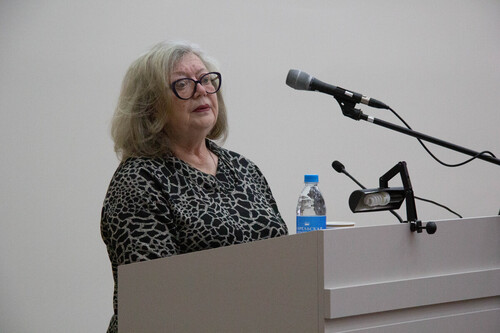
Tatyana Morozova, Director of the Institute of Economics KarRC RAS
Scientists have evaluated the influence of social, demographic and economic factors of regional development on shaping the educational potential of young generations.
— As we know, personnel availability for regional economies is currently a serious problem. The focus on the implementation of the regional education and training policy and the developments that are underway are crucial for the development of the region and stabilization of its economy. New generations with their own views and values are coming, but changes in the socio-economic sphere dictate certain requirements to the education system. We need smarter specialist training solutions, taking into account the staffing needs of the regional economy in order to provide foundations for the spatial development priorities of northern territories, — related the Institute’s Director Tatyana Morozova.
The results of studies in ecological economics were summarized in a monograph, which examines the conflict of interests arising from the introduction of technologies with the lowest ecological footprint and the wider use of organic products. Proposals have been formulated for authorities, agricultural producers and non-profit organizations, in particular, a new concept of creating a mechanism for the development of the organic products market.
Another focus of attention for Karelian economists last year was the environmental well-being of Arctic territories and the socio-economic aspects of their sustainable development. The scientists revealed how businesses, authorities, and citizens view their environmental responsibility and what green practices they use.
A model for grouping the country's regions by health care accessibility was built. The analysis showed that 2/3 of the regions fell in the group of those dissatisfied with the level of access to medical services. This group included 10 regions of the High North.
The patterns of change in the population of municipalities were studied. It was found that the rate of population decline in municipalities increased with distance to the capital city, but the population decline in northern regions was almost twice faster. Region-specific calculations showed that each entity had its own set of factors affecting the population dynamics: average salary level, availability of professional education institutions, large enterprises and transportation infrastructure.
A hundred academic papers were published in total based on the results of 2024 research, including 58 scientific articles.
In the reporting year, the Institute hosted the 13th Conference with international participation, dedicated to K.I. Arsenyev “Questions of Economic Geography and Spatial Development Statistics”.
Scientists of the Institute of Linguistics, Literature and History (ILLH) KarRC RAS carried out research on 40 projects, of which four were developed according to the research plan and state assignment, five projects were supported by the Russian Science Foundation, and one was supported by the Russian Geographical Society (RGS).
Director Irina Novak presented quite a number of publications reflecting the main outputs of the work of the Institute's historians, archaeologists, linguists and ethnologists. The focus last year remained on the settlement history and cultural heritage of Karelia, monitoring the state of petroglyphs and many other topics. The scientists published 106 papers, including 68 scientific articles and 11 books: 2 monographs, 4 proceedings volumes, 1 translation, 1 essay, 3 extended abstracts of doctoral theses.
The database “Karelian Runo Songs” was created; the texts therein are given in Karelian with translation and arranged by genres: epic, ballad, lyric, wedding and others. The structure of the database allows users to build a variety of queries to analyze runo song texts.
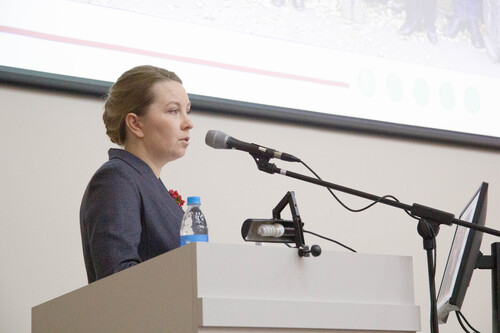
Irina Novak telling about the results of ILLH KarRC RAS work
A weighty output of the scientists’ innovative activities is content addition to the open-access geographical information system ”TopKar — Toponymy of Karelia”.
— This resource is a repository as well as a tool for analyzing field and archival materials. The database content allows displaying variants of place names, the evolution history of these names, administrative affiliations, structure, semantics and etymology, — the philologist remarked.
Activities within the project “Filling the audio map of Karelian and Veps dialects”, supported by a RGS grant, included three field trips: to the Kondopoga and Belomorsk District of Karelia and to the Tver Region. In total, 30 people were interviewed and over 40 hours of recordings of Karelian and Veps speech were collected, the language situation and the tourism potential of the areas were surveyed.
At the end of the year, a new theme was launched - preservation, cataloguing and digitalization of Karelia's historical and cultural heritage.
One of the most significant scientific events organized with participation of the Institute’s scholars was the Jubilee All-Russian Conference “Bubrikh’s Readings: Traditions and Novelties in the Study of Finno-Ugric Languages and Cultures”.
The completing part of the reporting session was the presentation by Olga Bakhmet, Head of the Department for Multidisciplinary Research (DMR) KarRC RAS. The unit's staff have fully implemented the research planned for the current year under six research themes, conducted research under six RSF grants, five commercial contracts and one public contract. Based on the results of the research, 53 papers were published, including 43 articles.
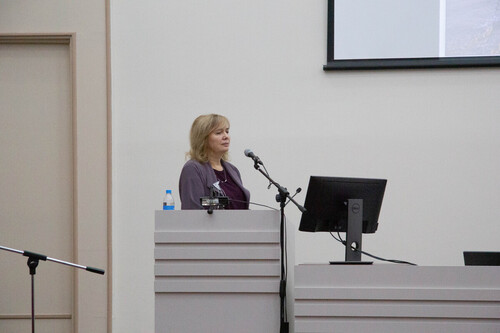
The work of DMR KarRC RAS being presented by the unit’s head Olga Bakhmet
A GPR technique was developed for studying tree roots, with Norway spruce Picea abies as the case study. This method enables the assessment of the transformation of root systems under external impacts and, potentially, biomass semi-quantification.
Software for trout farms has been developed. In addition to the methods for contactless “weighing” of fish, the developments include a technique for processing satellite images to prepare them for analysis by neural network algorithms, which help estimate the number of fish cages, determine their size and location.
In one of the RSC projects, the scientists assessed the development of crop plants in the North when cultivated alone or together with other species.
Other works of the Department's employees include the study of potato productivity, development of techniques to enhance farmland productivity and techniques for recycling pulp and paper industry wastes, research into the long-term effects of the COVID-19 virus on human health, study of permafrost in palsa mires of the Kola Peninsula, and many others.
Last year, integrated field trips to the Ladoga Skerries National Park with participation of staff of KarRC RAS institutes were organized.
— Field surveys combined with remote sensing data provided new information on the land cover, flora and fauna, environmental issues caused by recreational use, — noted Olga Bakhmet.
Research on the “carbon theme” within the RITM Carbon scientific consortium was continued. As part of this work, DMR KarRC RAS staff obtained new information on the revegetation of abandoned farmlands and carbon accumulation there.
One of the priorities for the Department's activities last year was the Arctic. The Youth Laboratory for Integrated Arctic Studies was established upon competition organized by the Russian Ministry of Science and Higher Education within the national project Science and Universities. The Arctic Development Workshop was continued. The workshop has become a platform for discussing research results and preparing new interdisciplinary projects of Karelian scientists under grants from the Russian Science Foundation and the Arctic Science and Education Center.
In 2024, the efforts were initiated to find topics for joint research with institutions of the Chinese Academy of Sciences. Collaboration with the National Academy of the Republic of Belarus was continued. Scientists visited the 2nd Innovation Forum in Minsk, where they presented their applied developments: laser analyzers of granules and droplet size. The first device is designed for automatic control of the particle size distribution of granulated products, such as mineral fertilizers, in industrial facilities. The second one is used to measure the size distribution of particles or liquid droplets and can be used in spraying systems and nozzles at the stages of their design, manufacturing and operation in various industries. The developments have already been put to use at a Uralchem enterprise.
Members of the Department were actively involved in organizing international events, including the conference “Regional Cooperation within the BRICS: sustainable nature management – environment, education, tourism” held in Petrozavodsk on September 18-20. During this conference, scientists from Russia, Belarus, China, South Africa, Ethiopia, India, Egypt, and Brazil discussed the questions of biodiversity conservation, sustainable use of natural resources, regional expertise in industrial ecology and green economy, climate change and other issues.
Wrapping up the Learned Council session, Olga Bakhmet announced the forthcoming session to be organized on February 11th jointly with the Petrozavodsk State University and the Russian Presidential Academy of National Economy and Public Administration to celebrate the Russian Science Day and honor the 80th anniversary of the Great Victory.




